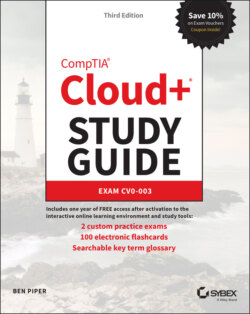Читать книгу CompTIA Cloud+ Study Guide - Ben Piper, David Higby Clinton - Страница 15
What Does This Book Cover?
ОглавлениеThis book, consisting of 10 chapters, follows the most recent version of the CompTIA Cloud+ exam, CV0-003. The exam blueprint is divided into five sections which are explained in sufficient detail to help you become a Cloud+ certified professional.
Chapter 1: Introducing Cloud Computing Configurations and Deployments The book starts out by investigating the most common cloud components, such as applications, compute, storage, and networking. Then it discusses how to determine the correct size and scale of the systems. You will gain a basic understanding of configurations found in the cloud and learn about production, quality assurance, and development of cloud systems.
Chapter 2: Cloud Deployments In this chapter, you'll learn about deploying services in the cloud and how to execute a deployment plan; the most common service models; and the various ways that clouds are delivered, such as public, private, and community. Common cloud terminology and storage are explained.Next, the chapter delves into the technical background and you'll learn how to determine the needs and design of an effective cloud deployment. This includes what virtualization is, its benefits, and why it's a central technology in cloud computing. You'll learn about hypervisors and virtual machines, and how to migrate from your existing operations to the cloud.
Chapter 3: Security in the Cloud This chapter covers cloud security, starting with security policies, laws, and standards. You will then learn about specific security technologies, applications, and services.
Chapter 4: Implementing Cloud Security This chapter builds on your security knowledge by explaining how to implement secure storage, networks, and compute systems. Security tools, intrusion systems, encryption, tools, techniques, and services are introduced.
Chapter 5: Maintaining Cloud Operations This chapter focuses on keeping your cloud deployment current with the latest updates, and it discusses the processes to follow. Automation is introduced, and you will learn about the importance of cloud automation and orchestration systems. The chapter concludes with a discussion of backing up your data in the cloud.
Chapter 6: Disaster Recovery, Business Continuity, and Ongoing Maintenance We'll take a step back in this chapter and cover how to go about developing a disaster recovery plan and the common models available. You will learn the importance of business survivability during a severe outage and understand the issues concerning recovery. The chapter ends by describing how to perform ongoing maintenance in your cloud environment.
Chapter 7: Cloud Management You'll now delve deeply into the operations aspects of cloud computing. This chapter begins with a discussion of monitoring the cloud, and then it moves on to look at the allocation and provisioning of resources. Then you will learn about business requirements, application life cycles, and the impact they have on managing your cloud deployment. The chapter concludes with a discussion on the security of your cloud operations with accounts, automation, authentication, and automation models.
Chapter 8: Cloud Management Baselines, Performance, and SLAs This chapter explains how to determine what is considered normal cloud operations by creating and maintaining baseline measurements. Using these measurements, you can monitor your cloud fleet for deviations from the baseline and learn the steps to take when this occurs. Service level agreements and chargeback models are also explained in this chapter.
Chapter 9: Troubleshooting This chapter goes deeply into the technical aspects, identifying and correcting cloud technical issues. Troubleshooting of new and existing deployments is covered. You will learn about common problems found in the cloud that you will need to resolve. You will learn how to identify and resolve deviations from your baselines and what to do when breakdowns in the workflow occur. Be sure to pay close attention to this chapter!
Chapter 10: Troubleshooting Networking and Security Issues and Understanding Methodologies The final chapter continues investigating troubleshooting with a focus on tools and techniques. Common troubleshooting utilities found in Linux and Windows systems are presented, and you'll learn how to perform a structured troubleshooting approach.
Appendix A: Answers to Review Questions This appendix contains answers to the book's Review Questions.
Appendix B: Answers to Written Labs This appendix contains the answers to the book's Written Labs.
